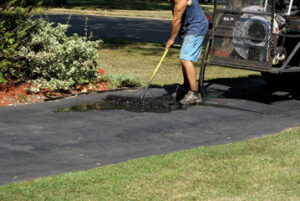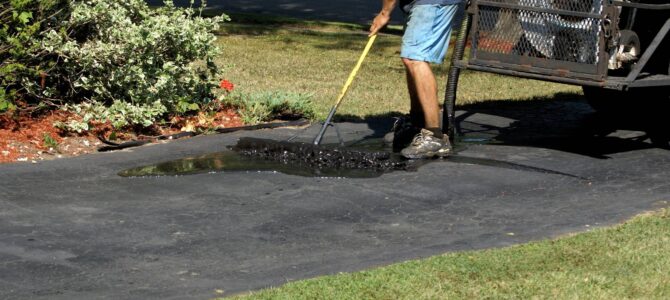Concrete driveways can be repaired with a liquid crack filler available at hardware stores. Asphalt driveways are often repaired with cold patch asphalt or a specialty product. Grease and oil stains can be removed with a commercial grease and oil remover.

Sunken sections of a driveway may be leveled with mud jacking. This process involves drilling slightly larger holes into the driveway and pumping a mixture of polyurethane foam and sand underneath the slab, raising it back up to its original level. Contact Driveway Repair Charleston, SC for professional help.
The concrete used to build a driveway takes a beating from the elements. Heat, cold, rain, snow and sleet damage it over time. This damage can take the form of cracks, pitting, flaking, unevenness and stains. Repairing your concrete driveway at the first signs of these issues helps keep it safe to walk on and drive over and prevents further damage from occurring.
Small cracks in the surface are a normal part of the aging process for most concrete. When left untreated, these cracks will grow and eventually weaken the surface of your driveway. These cracks can also allow water to seep through, which freezes and erodes the underlying materials. Water can also carry salts and other chemicals into these holes, which will further deteriorate the concrete. Repairing your driveway at the first signs of these issues will help you avoid costly repairs down the road.
If your driveway has a few hairline cracks, you can fill them in with a liquid crack filler and sealer. These products typically come in no-mess cartridges for a caulking gun or pourable squeeze bottles. Apply the filler to the cracks and smooth it out with a putty knife.
For bigger cracks, you may need to use a concrete patching compound that is designed for this type of damage. These kits contain everything you need to make a permanent repair to your concrete driveway. Apply the product according to the manufacturer’s instructions.
Before you attempt to fill any cracks, be sure that the weather is warm enough for the material to set. Clean the area of your driveway to be repaired of any plants, dirt or weeds. Hose the area down and spray it with a weed killer. If you need to, you can also remove weeds and grass by digging them up with a shovel or garden tools. This will ensure that the cracks you are trying to fill in do not get messed up by any growth.
If your cracks have widened, are deep or are an alligator pattern that appears as interconnected plates and scales, you’ll need to call in a professional for a more extensive concrete repair solution. Typical solutions like simple crack sealing or mudjacking will provide temporary relief, but won’t address the root cause of the problem — unstable soil that needs to be stabilized. A more permanent, long-term treatment includes concrete lifting, which uses specialized methods to lift and stabilize sunken sections of your driveway.
Sunken Sections
A sunken section in your driveway can be an unsightly and even dangerous tripping hazard. It can also indicate a serious problem with the foundation of your house and should be addressed right away to avoid further damage. Fortunately, it is now possible to repair sunken concrete surfaces without the need for costly removal and replacement.
Many newer homes experience issues with their driveways shortly after they are installed. This is often because the soil wasn’t properly compacted or because heavy vehicles were used on the surface before it had a chance to settle.
Erosion is another common cause of sinking concrete. This occurs when water washes dirt from beneath your driveway, creating a void or space that can cause the slab to sink over time. This issue is compounded by clogged gutters, downspouts, and poor yard drainage.
The temperature of your area can also create problems for a driveway, especially if it is made of concrete. The Little Rock area is known for having dramatic temperatures throughout the year, ranging from hot and humid to cold and snowy. These temperature changes can cause the ground to freeze, thaw, and expand, which puts a lot of pressure on the concrete and causes it to crack or sink. This is called a frost heave and it can be very difficult to fix on your own.
There are a few different ways to fix a sunken slab of concrete, but the most effective and least expensive way is to hire a professional. Some companies use a process called mudjacking to raise the slab. This involves drilling holes into the concrete and then pumping a mixture underneath it to lift it. Unfortunately, this method doesn’t address the root of the problem and is only a temporary solution.
There are other methods that involve removing the old slab and pouring a new one. This is a much more expensive option and it can create a noticeable difference in appearance between the new and old sections of the driveway. There is also the risk that it may sink again in the future because the new slab will be sloping toward your home and causing water to run down into the foundation.
Rough Edges
A good edging system is essential to the longevity of your driveway. It will help transfer the weight of your vehicle to the solid ground beneath it, rather than allowing the asphalt to shift, crack or sink into the soft soil around it.
The edging also helps to keep weeds, dirt and mulch from migrating from the lawn to the asphalt. This helps you to keep your lawn looking pristine and allows you to easily mow and edge your driveway without worry about damaging the asphalt.
Crumbling or jagged edges are an indication that the edging has been compromised and may be a sign that it is time to replace it. However, this is a costly undertaking that can be avoided with the use of more durable edging materials and regular maintenance.
If you have concrete driveway edging, a topical sealer will enhance its appearance and protect it from the elements. This will also make it easier to clean, reducing the amount of effort needed to keep it looking great.
Driveway edging is also a good way to prevent water from pooling on the surface of your driveway and potentially damaging it or causing erosion problems. The edging should be sloped slightly away from your house to ensure that the water flows into the gutter and doesn’t collect on the surface of the driveway.
When it comes to asphalt, there isn’t as much of a problem with drainage issues, but if you notice that the edges of your driveway are crumbling or have become disintegrated, it may be time to invest in a new set of edging. This isn’t just a cosmetic issue; it can affect the structural integrity of your driveway and lead to further problems down the line.
For a simple solution, you can use a plastic landscape edging product that is specifically designed for driveways. To install this, start at one end of the driveway and use wooden stakes to create a straight line along the path you’d like the edging to cover. Then, measure the length of your chosen edging material and cut it to the appropriate size. Be sure to double-check your measurements so that you get a precise fit during installation.
Clean the Area
If your concrete driveway is looking worn out and patching just isn’t enough, you may want to consider replacement. A full replacement is a more expensive option than just fixing the cracks, but it can help extend the life of your concrete for decades.
Before you start working on your driveway repair, make sure it’s free of dirt, debris and weeds. A broom or power washer is usually enough to remove most of the dirt and grit from your concrete, but you’ll need a stronger tool for more stubborn grime. Start by soaking the affected area with water and pre-treating tree sap, gum or other stubborn stains with a full-strength cleaner or degreaser. Then, use a stiff brush to scrub away the stain, making sure to get into the cracks and holes as well. After you’ve finished scrubbing, rinse the affected area with a hose.
For smaller cracks less than a quarter inch, you can often fix them with a driveway filler or sealant that’s dispensed from a caulking gun. For cracks wider than a quarter inch, you’ll need a cold asphalt repair product like Quikrete Concrete Resurfacer (available at Lowe’s). It comes dry in a 40-pound bag and must be mixed with water according to the package instructions.
Larger cracks and holes represent more extensive damage underneath the surface of your driveway, but most are still repairable. If the cracks are wide and deep, you can try surface patching, which is a bit more intensive than just filling in the cracked areas. For a badly damaged driveway, dig out patching is also an option. This requires removing the entire section of cracked and broken asphalt, cleaning the hole, and then installing new asphalt from the ground up.
To avoid expensive driveway repairs in the future, it’s recommended that you get your driveway sealed once a year. This prevents further damage by filling surface voids, reducing exposure to UV rays and oxygen, and limiting the depth that gas or oil can penetrate the pavement. It also helps to keep weeds and grass from growing in or around your driveway, as they can cause further damage by pushing through the cracks and softening the concrete or asphalt.


